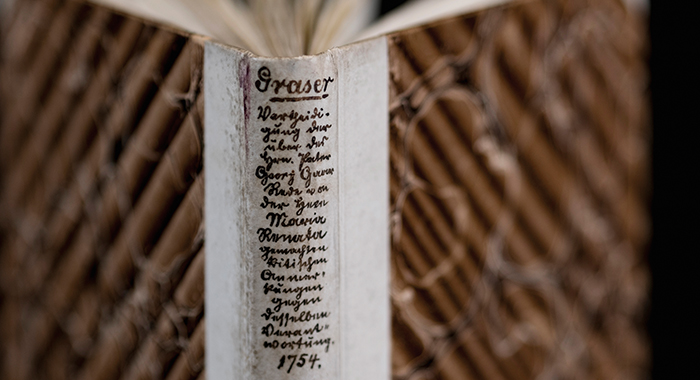A Witch Hunt in the Convent
Hand written in ornately scripted German and bound in leather, the 272-year-old book is beautiful to behold. The story inside, however, is full of darkness. Its topic: the trial and execution of a Norbertine nun accused of witchcraft.
Sally Cubitt, now retired from the Mulva Library, found the book listed online by an antiquarian bookshop in Belgium that specialized in Catholic history. “We had some monies in the budget to find some Norbertine materials for our rare book collection,” Cubitt says. “When I saw the listing for the book, and did some research on it, I was hooked. It’s really a fascinating glimpse into history and the social and psychological aspects of witchcraft.”
Rosemary Sands, former director of the Center for Norbertine Studies, has undertaken extensive research on the book itself and the history of the accused nun, Sister Maria Renata Saenger Von Mossau. “I think it’s fascinating,” says Sands. “From what I have found through my research, her trial and execution was the first witch trial in over 100 years in that part of Europe. People found witch trials antiquated by that time – they had fallen out of favor. I’m thinking it was a perfect storm of weird stuff going on in the convent and a punitive person who decided to put her on trial and follow through with the execution.”
Von Mossau was 65 years old when she was accused of witchcraft, after having spent nearly 50 years as a Norbertine nun in the Unterzell convent in Bavaria. “As early as 1738, things weren’t right at the convent,” says Sands. “There seemed to be resentment and envy, and there was a younger member of the order who was having convulsions. Other women began having convulsive episodes too, which some suspected were demonic possessions. Another sister accused Sister Maria Renata of being a witch and causing the problems.”
While it is impossible to know the full truth about what led to the accusations, Sands has a theory. Through her research, she discovered that at the same time the larger community had been hit with difficult times: a bad harvest and a spike in illnesses and deaths. “You can imagine in a small-town atmosphere the people gossiping about these things, wanting someone to blame,” Sands says. “I think they were looking for a scapegoat and she was handy. They searched her room and supposedly found evidence of sorcery – a gold and yellow robe or cape and herbs.”
Sister Maria Renata was interrogated, first in the convent, then by a commission two weeks later. “She was in such frail health she had to be carried into [the] interrogation room,” Sands says. “She was calm and praying.” She ultimately confessed to witchcraft; Her religious position earned her the “privilege” of beheading before facing the stake. In June 1749, as her body was burned before a crowd, her head was placed on a stake in front of the bonfire, facing the Unterzell convent.
A modern perspective
The account of these events in the SNC collection contains the sermon given by Jesuit priest Georg Gaar as her body burned. He preached that this might be a warning from God for a modernizing society where some had abandoned their belief in witches, magic or the devil.
“We now look back on these trials as horrific, brutal, and misogynistic and understand that the accusations of witchcraft were false and often lobbied at women who were strong and outspoken,” says Karlyn Crowley, former professor of English and women's and gender studies and former director of the Cassandra Voss Center at St. Norbert College. “Perhaps the most shocking element of this witch accusation is that it is so late in history occurring, ironically, in the 18th-century Age of Enlightenment!”
Both Crowley and Sands are hopeful that Sister Maria Renata’s story, viewed through a modern lens, will promote thoughtful discussion about the history of gender-based persecution. “I think it was so sad,” says Sands. “She spent 50 years in the convent devoting her life to God and she gets this for her reward.”
Gender’s role in witch hunts
“Gender is a key element in understanding who was accused of witchcraft both in Early-Modern Europe and the Salem, Massachusetts witch trials that Americans are most familiar with. Roughly 90 percent of those accused of being witches were women. People believed that women were vulnerable to being wooed by the devil and demons and couldn’t resist the temptation; women were also viewed as “sinful” particularly because they were hyper-sexualized. Typically, we also think that such trials could not happen again; however, how often do we still punish outspoken women or shame women’s sexuality and behavior? Those sexist stigmas still live on.”
—Karlyn Crowley, former St. Norbert College professor of English and women's and gender studies, and former director of the Cassandra Voss Center.
The Year of Norbertine Women
Sister Maria Renata Saenger Von Mossau was one of the Norbertine women highlighted during the 2019-2020 Center for Norbertine Studies lecture series. “She didn’t have a voice,” says former director Rosemary Sands. “The sisters and nuns get forgotten. We want to shed light on the most memorable ones.”
Nov. 5, 2021












